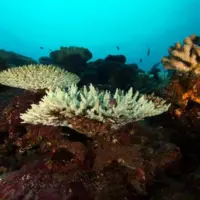
While the coral reefs surrounding American Samoa remain relatively healthy, resource managers are preparing for the possibility of future outbreaks—especially as coral diseases have devastated reefs elsewhere, such as those in the Western Atlantic.
The best defense is preparation: equipping scientists with the tools and training to respond swiftly and effectively when a threat appears.
To that end, the science team at National Marine Sanctuary of American Samoa collaborated with the Coral Reef Advisory Group (CRAG) to conduct training on techniques for sampling corals for diseases. This hands-on workshop aimed to build local capacity to detect, document, and respond to coral disease.
Led by the sanctuary’s research coordinator, Val Brown, participants learned how to properly identify disease symptoms, collect coral samples in the field, and process them for analysis.
The sampling protocol follows a standardized methodology designed by Dr. Thierry M. Work of the U.S. Geological Survey’s National Wildlife Health Center – Honolulu Field Station. This approach has been successfully implemented in coral reef regions across the Pacific, and now includes American Samoa.
By increasing CRAG and sanctuary staff’s ability to collect and analyze samples, the region will be better prepared to monitor trends and respond if an outbreak occurs. Although this was a training exercise, any viable samples collected will be sent to Dr. Work for histological analysis, contributing to broader efforts to identify and understand coral diseases affecting reefs across the Pacific.
While training scientists is critical, long-term reef health also depends on community awareness and stewardship. That’s why, on May 2, 2025, the sanctuary’s education team brought ocean literacy to the classroom through the Ocean Tales Reading Program at Tafuna Elementary School.
More than 60 third-grade students learned how coral reefs support marine life, how human activities impact reef ecosystems, and what they can do to help.
From reducing pollution to practicing responsible recreation, students left with a better understanding of their role in caring for the ocean. At the end of the session, students made a public pledge to be good stewards of the land and sea.
To support both scientists and divers in the field, the National Wildlife Health Center and its partners have created coral disease ID cards. These waterproof field guides help observers identify and describe lesions on coral colonies. Customized for regions including Hawaii, American Samoa, and New Caledonia, the cards can be laminated or printed on underwater paper for repeated use.
Source: National Marine Sanctuary of American Samoa




